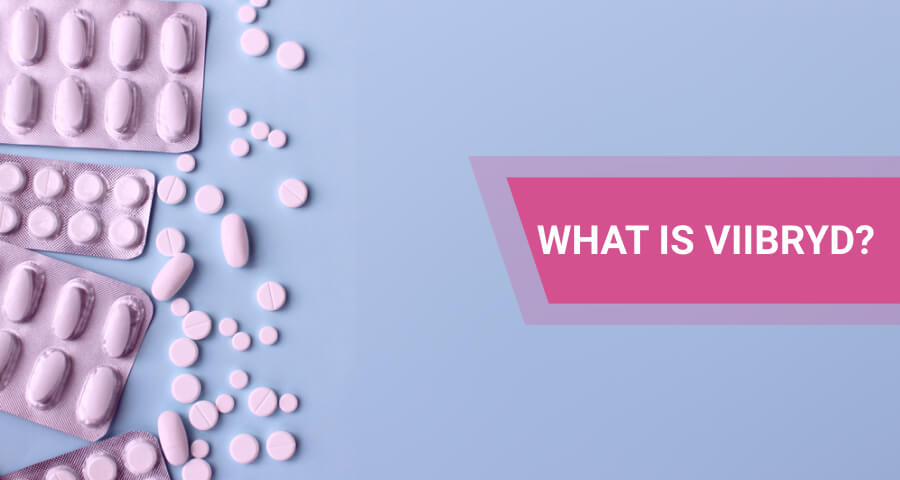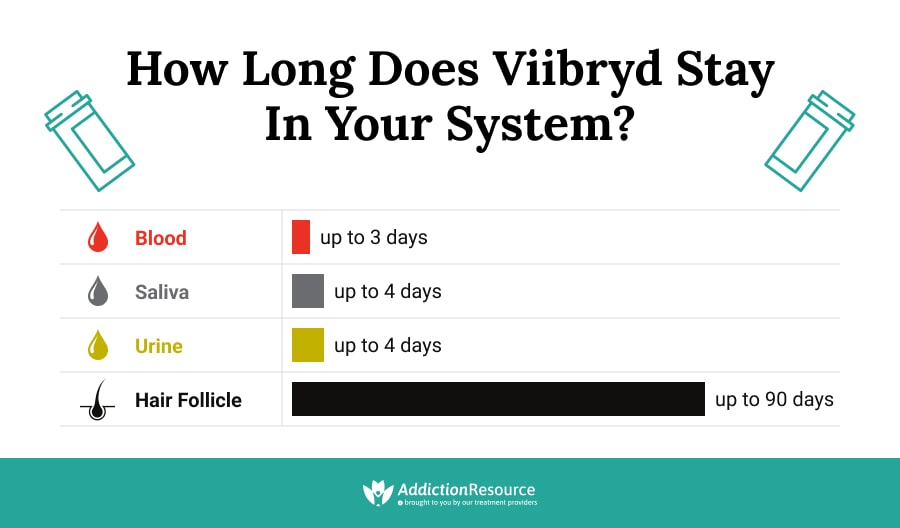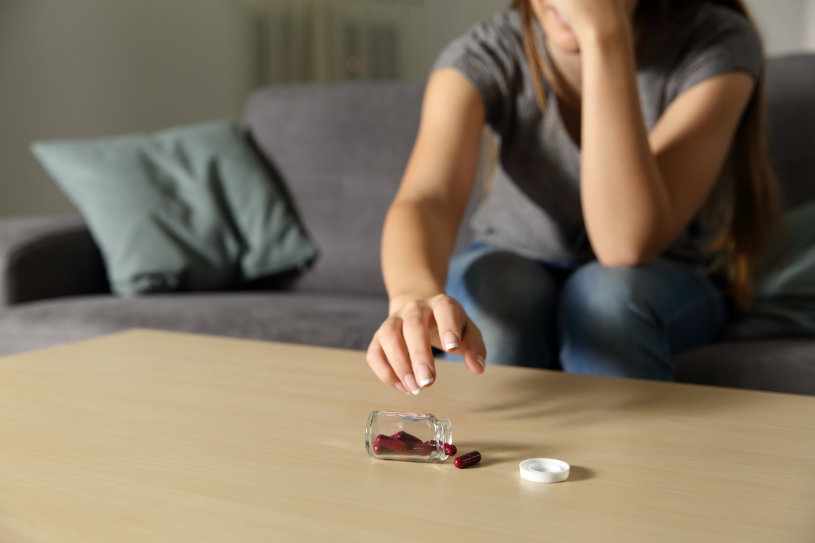
Viibryd is the brand name of the drug Vilazodone. It is used to treat major depressive disorder and other mental health problems such as anxiety. In the United States, around one million prescriptions of this drug are being given by doctors to treat depression. Although this drug is safe and effective if used properly, it is important to know that inappropriate use of it, such as long-term use and missed doses, may cause dangers to health. In this article, information about the drug’s dangers, the risks of addiction, Viibryd abuse, withdrawal symptoms, and treatment options will be provided.
Table Of Contents:
In the United States, around 40 million adults (18 years old and above) are experiencing anxiety disorders every year.
More About Antidepressants:
What Is Viibryd?
Viibryd medication, under the generic name Vilazodone, is a prescription medication sold in the United States, and it is designed to treat major depressive disorders. This drug is not a controlled substance. It is manufactured by Allergan and was approved by the FDA for use in January 2011. This medicine is an SSRI, which means it selectively prevents the reuptake of serotonin in the brain. However, it is unique in its class because of its partial agonism of the 5-HT1A receptor. These actions of the drug appear to have a positive impact on the symptoms of major depressive disorders and other mental health problems.
Viibryd Generic And Brand Names
Viibryd generic is Vilazodone. Before the FDA had approved the generic Vilazodone, the only brand available was Viibryd medication. Today, in the United States, there is another brand name known, and that is the brand Vilazine. It is important to know that Viibryd generic is the same as the new brand Vilazine. A doctor may prescribe a Viibryd generic or other brands depending on the available brands in the country. In India, for instance, Vilazodone is available under the brand names Valz, Vilano, Zovane, Vilarest, Vilamid, and Neuvilaz.
Viibryd Dosage Strengths And Forms
Vilazodone is a prescription medication approved for the treatment of major depressive disorders but also used off-label for other conditions. Viibryd dosage is available in three strengths: 10mg, 20mg, and 40mg film-coated tablets. However, doses of this drug can vary based on the reason for treatment and the individual needs of the patient. Also, all Viibryd dosage strengths come in the form of a tablet, and all tablets are oval in shape. Below is a chart about the Viibryd dosage strengths might look like:
| DOSAGE | COLOR | IMPRINT |
| 10MG | Pink | “10” on one side |
| 20MG | Orange | “20” on one side |
| 40MG | Blue | “40” on one side |
Do not self-medicate. The Viibryd dosage strength to be used will be determined and prescribed by a doctor.
Vilazodone Mechanism of Action And Drug Class
The drug class and mechanism of action of Viibryd medication are something every user should understand. Not only does it make it clear what the medication is meant to treat, but it also reveals how the medication works and how it is accessed. Vilazodone falls into the class of antidepressant drugs called serotonin modulators. Specifically, it is an (SSRI) partial serotonin agonist and reuptake inhibitor. The mechanism of action of this drug is to stop the body from fully re-uptaking serotonin in the brain, leaving more of the feel-good chemical present while also functioning as an activator of the 5-HT1A receptor. This differs from SRIs, which are not selective in how they prevent reuptake and do not interact with the 5-HT1A receptor.
Like most antidepressant drugs, the exact manner in which Vilazodone works is unknown. However, there are some assumptions that have been made regarding its mechanism of action. Users should fully understand this before taking the drug for any Vilazodone uses.

How Fast Does Viibryd Work?
Antidepressant drugs are slow-acting medications, so it refers to Vilazodone as well. In some cases, patients will start to show small improvements within one to two weeks of starting the medication. These tend to be smaller symptoms, such as improving appetite and sleep. Within eight weeks, most patients will be able to feel the full effects of the drug.
Vilazodone Uses
The major and labeled indication of Vilazodone is for the treatment of major depressive disorders. However, this drug is also used for off-labeled indications and other mental health problems or disorders. Off-label use means a drug is approved to treat other conditions aside from its main indication. Some of this drug’s off-label uses are for the treatment of anxiety disorders, bipolar disorders, chronic pain, vasomotor disorders, and post-traumatic stress disorder.
Viibryd For Depression
Viibryd medication falls into the drug class of antidepressants – specifically, SSRI. It is cleared by the FDA strictly for the treatment of major depressive disorders. In this treatment, it is considered a safe and effective option. However, Vilazodone is not suited to treating all forms of depression. For mild to moderate depression, its effects have not even been studied. It has also not been studied in the treatment of depression combined with mania, also known as bipolar disorder.
When compared to other forms of depression treatment, it is generally equally effective in major depressive disorders. However, side effects and other symptoms of use may mean that other medications are better suited to the patient.
Viibryd Off-Label Uses
While they are not among the Vilazodone indications, this drug can be used to treat other conditions or disorders. These are called off-label uses because they have yet to be given FDA approval. In some cases, these Vilazodone hydrochloride uses may not have been studied in an official capacity. Instead, doctors prescribe them for these uses based on past observations by themselves and their colleagues or because other drugs within the serotonin reuptake inhibitors have been shown to treat these conditions.
Viibryd For Anxiety
The most common off-label use of Vilazodone is for the treatment of anxiety. Limited studies seem to show that adults with a generalized anxiety disorder who are given the drug can see improvement. However, this is limited strictly to GAD and cannot be extrapolated to other forms of anxiety, such as social anxiety.
Viibryd For OCD
A less common Vilazodone use is the treatment of obsessive-compulsive disorder or OCD. However, this has not been well-studied at this time. This means that there could be an unknown risk in its use. Users should weigh this when considering a use not part of the Vilazodone indications.
When there is Viibryd abuse, the risk of having addictive behavior, which implies the inability to control oneself in the use of a drug, increases.
Vilazodone Half-Life And How Long Does it Stay in the System?
For those using Vilazodone, it is essential to know how long the drug remains in the system. The Vilazodone half-life is quite long when compared to other antidepressants. While most have a half-life of around a day or even less, Vilazodone does not hit half-life for 140 hours in the average patient. Those with slow metabolisms or impairment of the hepatic or renal systems may take even longer to reach this point.
Below Is Some Information about How Long This Drug Stays in the Blood, Urine, Saliva, and Hair:
- Blood – up to 3 days
- Urine – up to 4 days
- Saliva – up to 4r days
- Hair – up to 3 months
This information is most important when it comes to taking other medications or using various substances, such as alcohol and marijuana. Some users might want to consider it when it comes to drug testing as well. While standard tests will not look for antidepressant medications, some of these medications will result in false positives. At this time, there is no data showing that Vilazodone drug tests may cause false positives, but it is possible that studies could reveal such a link in the future.

Overview of Viibryd Abuse And Addiction
There is a risk for antidepressants to cause addiction and abuse. Regarding Vilazodone, it is less likely to cause abuse and addiction compared to other antidepressants, and there have been no reports about Viibryd abuse and addiction today. However, Viibryd abuse may be caused by physical tolerance and dependence, which makes it harder for a person to stop using the drug.
What Makes Viibryd Addiction And Abuse Possible?
Addiction is a condition where a person is compulsive with the use of substances despite the harmful effects. Individuals may have Viibryd abuse and addiction due to different reasons. Below is some information about what causes these individuals to abuse this drug:
- Individuals have a prior substance abuse – This factor is related to social stressors. A person who is exposed to stress at an early age has the possibility to use substances at an early age. Eventually, the earlier a person begins to use drugs increases the chance for that person to become addicted later on. Additionally, a person who has prior substance abuse may experience relapse and this is a factor for that person to become addicted to other drugs again.
- Misuse in the administration of the drug – Misuse includes the following: modifying the doses in order to achieve the effect faster, taking someone else’s prescription, consuming larger doses than prescribed, and simply not following the recommendations of the prescriber.
- Peer influence – Interaction and influence from peers with addictive and risky behaviors is another factor why Vilazodone abuse and addiction are possible. This factor is most common for teens.
When there is Viibryd abuse, the risk of having addictive behavior, which implies the inability to control oneself in the use of a drug, increases. Drug addiction is harmful, but it can be prevented as long as there is self-discipline and openness for help from other people, especially from healthcare professionals.
Who Is Most At Risk Of Addiction?
A person may suffer anxiety disorders which may lead to depression. In the United States, around 40 million adults (18 years old and above) are experiencing anxiety disorders every year. In the United Kingdom, around 7.3 million are diagnosed with depression. These individuals with anxiety and depression are most at risk of Viibryd addiction and other antidepressant addiction.
Below Is a Piece of Additional Information About the Risk of Addiction of Individuals With Respect to Some Characteristics:
- Male sex – 11 out of 12 males have substance use disorder which makes these individuals more addicted to those substances compared to females with 6 out of 12 statistics record.
- Individuals with personality problems – Personality problems such as Borderline Personality Disorder, Antisocial Personality Disorder, Narcissistic Personality Disorder, Avoidant Personality Disorder, OCD Personality Disorder, and Dependent Personality Disorder.
- Individuals with prior substance abuse – Individuals with prior substance abuse are prone to relapse and this may cause them to go back to their addictive lifestyle either in the use of drugs or alcohol.
- Patients incorrectly diagnosed with depression causing them to take unnecessary antidepressant medications.
In another study, it was reported that childhood maltreatments are a risk factor for individuals to use substances such as drugs and alcohol at an earlier age and this may cause them to be more at risk of addiction.
When antidepressant drugs, including Vilazodone, are taken inappropriately, such as during misuse or abuse, danger of withdrawal aside from addiction may occur.
Symptoms and Signs of Addiction
Antidepressant drugs, including Vilazodone medication act in the brain. Therefore, addiction to the drug may affect the psychological/behavioral, and physical abilities of a person. A person’s signs and symptoms of addiction differ from one another. Below are the symptoms and signs of addiction with regards to psychological/behavioral and physical changes of a person:
Psychological & Behavioral Symptoms And Signs of Addiction
When a person has used a drug inappropriately, addiction and dependence may occur. Factors of these addiction and dependence are loss of control in the use of the drug and continued use of it despite the consequences.
Below Are the Following Symptoms and Signs Which a Person May Exhibit during Viibryd Addiction:
- Losing interest in life and favorite activities
- Obsession with taking and obtaining the drug
- Going to different doctors to get prescriptions of the drug
- Secretive about activities
- Financial problems
- Interest in conversations using Vilazodone and other drugs as the topics
There is also a risk of having emotional changes aside from behavioral ones. Examples of emotional signs and symptoms of addiction are blaming, denial, and defensiveness. If someone is struggling with substance abuse and showing the psychological/behavioral signs above, it is important to seek help immediately.
Physical Symptoms and Signs of Addiction
Aside from the psychological/behavioral symptoms and signs of addiction, physical changes may also be seen in a person with Viibryd addiction. It is important to understand that addiction is progressive, and as time passes, a person struggling with Vilazodone addiction will show more physical changes. Some of these changes are the following:
- Unable to function normally when the drug is not taken
- Seizures
- Irritability
- Tingling sensation
- Change in eating habits
- Compulsiveness
The symptoms and signs listed above are dangerous. That is why it is important to always get the guide of a doctor when taking this medicine in order to prevent misuse, abuse, addiction, and even other undesired symptoms and signs.

Possible Dangers of Vilazodone Use And Abuse
When antidepressant drugs, including Vilazodone, are taken inappropriately, such as during misuse or abuse, possible dangers aside from addiction may occur. Below is information about Viibryd withdrawal, interaction of Viibryd and alcohol, and overdose.
Viibryd Withdrawal
It is common for users to want to stop using Vilazodone at some point. This could be due to negative side effects, feeling addicted, or just wanting to try living a medication-free life. It is a must for users to talk with a doctor before stopping Vilazodone usage to discuss whether they should try cold turkey or taper off the medicine:
- Cold Turkey. Stopping the use of this drug suddenly, also known as going cold turkey, is a dangerous method of quitting the medication. This can trigger a condition called antidepressant discontinuation syndrome. In most cases, the physical symptoms are mild, but the major concern is with the mental health of the patient. Suddenly stopped drugs could cause depression symptoms to return quickly and be felt more greatly. This also means the risk of suicidal thoughts and tendencies is higher. Users should never go cold turkey unless it is what their doctor recommends. Even then, they should be carefully supervised.
- Tapering. Tapering off Vilazodone is considered the safer option. This means that the patient will slowly reduce their doses and possibly space them out further until they are no longer taking the drug. While this can still trigger antidepressant discontinuation syndrome, it is less likely to, and when it does, the effects tend to be milder. Users should still be monitored, though, as some side effects, especially those related to mental health, are still possible.
Viibryd Discontinuation Symptoms
Viibryd withdrawal symptoms can mimic a relapse in depression, so users should be carefully monitored after stopping or reducing the drug. Among the Vilazodone Withdrawal Symptoms Are:
- Lethargy and fatigue
- Headaches
- Muscle aches
- Sweating
- Difficulty sleeping
- Vivid dreams
- Nightmares
- Auditory hallucinations
- Dizziness and light-headedness
- Vertigo
- Burning and tingling sensations
- Electric sensations, such as brain zaps
- Anxiety
- Irritability
- Aggression
- Mania
If someone has stopped taking the medication and has begun experiencing these symptoms, they should notify a doctor.
How Long Does Viibryd Withdrawal Last?
There is no exact time when talking about how long the Viibryd withdrawal symptoms last. However, medical intervention and detox can ease or stop the symptoms sooner. The duration of the withdrawal symptoms depends on the following:
- Length of time in taking the drug
- How many doses have been taken
- Diet and other medications being taken
In most cases, starting a new antidepressant will stop withdrawal within days. However, users should never do this on their own, as starting another antidepressant too close to stopping Vilazodone could result in serotonin syndrome, which can be deadly.

Viibryd And Alcohol Interaction
When it comes to any drugs, there might be an interaction. These interactions may be food-drug and drug-drug, and may be considered mild, moderate, or severe. Viibryd and alcohol fall under the food-drug interactions. Alcohol can affect the mood of a person and may interfere with drug treatment. Taking Viibryd and alcohol together can make the side effects of the former more severe. This means a user will feel very drunk off of less alcohol, and the side effects of the medicine, such as lethargy, will become greater. As a result, users should avoid taking Vilazodone and alcohol together, as it can compromise their safety.
Viibryd Overdose
As with any other medication, a Vilazodone medication overdose is possible, and this may cause a risk. In most cases, an overdose is unintentional when a patient takes more than prescribed (exceeding the maximum daily dose) to manage the symptoms faster. It also can be a result of a missed dose, when a patient takes a double one; or if a patient forgets when the last dose has been taken. No matter the reason, overdose may be uncomfortable.
Users Should Be Mindful Of the Signs of a Vilazodone Overdose, Which Include:
- Nausea
- Vomiting
- Blurred vision
- Dilated pupils
- Confusion
- Headache
- Drowsiness
- Fever
- Lack of motor control
- Changes in respiration
- Rapid or very slow heartbeat
- Hallucinations
- Seizures
- Coma
A Vilazodone overdose can occur at a lower dose when other medications or substances are used at the same time. These can include prescription medications or alcohol. If someone experiences an overdose on Vilazodone, it is pivotal to go to a doctor and seek emergency medical attention at once.
Getting Help: Viibryd Addiction And Abuse Treatment Options
Vilazodone addiction is not easy to overcome alone that is why treatment, support, and help should be given. Getting is a way for a person to manage undesired signs and reduce other withdrawal symptoms. Below are some treatment options for Viibryd addiction and abuse:
Vilazodone Detox
The first step in kicking out Viibryd addiction is by doing medical detox. Detox includes tapering down or lowering the dose of Vilazodone gradually. This process will help a patient to avoid experiencing withdrawal symptoms.
Drug Rehabilitation Programs
After Vilazodone medical detox, it is important to consider drug rehabilitation programs. When choosing between in-patient or out-patient rehabilitation programs, it is a must to consider the needs of the patient as this can help make the process easier.
In-patient rehabilitation program
In this program, a patient will live on campus for a specific time to safely recover from addiction. Additionally, group and individual counseling services will be provided in this program.
Out-patient rehabilitation program
This is another treatment option where a patient may choose to live at home and attend a scheduled treatment whenever there is. It is also possible to attend an in-patient rehabilitation program and then attend an out-patient rehabilitation program after.
Sobriety Support Group
Joining a sobriety support group is another help option as well. Usually, a group of people recovering from addiction will have to meet once or twice a week to give support to one another.
Aside from the support options above, a person struggling with Vilazodone addiction may reach out to health care professionals for help.
Hope Without Commitment
Find the best treatment options. Call our free and confidential helpline
Most private insurances accepted
Find Drug Rehabilitation Centers Near You Anywhere In the US
Addiction Resource team has compiled an extensive list of the top drug rehabilitation facilities around the country. Use our locator tool to find the best centers near you.
Page Sources
- Boinpally, R., Alcorn, H., Adams, M. H., Longstreth, J., & Edwards, J. (2013). Pharmacokinetics of Vilazodone in Patients with Mild or Moderate Renal Impairment. Clinical Drug Investigation, 33(3), 199–206.
- Cruz, M. (2012). Vilazodone HCl (Viibryd). Pharmacy and Therapeutics, 37(1), 28–31.
- Durgam, S., Gommoll, C., Forero, G., Nunez, R., Tang, X., Mathews, M., & Sheehan, D. V. (2016). Efficacy and Safety of Vilazodone in Patients With Generalized Anxiety Disorder. The Journal of Clinical Psychiatry, 77(12), 1687–1694.
- Gabriel, M., & Sharma, V. (2017). Antidepressant discontinuation syndrome. CMAJ : Canadian Medical Association journal = journal de l'Association medicale canadienne, 189(21), E747.
- Gandhimathi, R., & Balammal, G. (2013). SSRI Discontinuation Syndrome – A Review. International Journal of Medicinal Chemistry & Analysis, 3(1), 43–48.
- Gazewood, J., Parker, S., & DeGeorge, K. (2013). Vilazodone (Viibryd) for the Treatment of Depression. American Family Physician, 88(4)
- Gommoll, C., Forero, G., Mathews, M., Nunez, R., Tang, X., Durgam, S., & Sambunaris, A. (2015). Vilazodone in patients with generalized anxiety disorder. International Clinical Psychopharmacology, 30(6), 297–306.
- Haddad, P. (1999). Do antidepressants have any potential to cause addiction? European Neuropsychopharmacology, 9, 231.
- Harmer, C. J., Duman, R. S., & Cowen, P. J. (2017). How do antidepressants work? New perspectives for refining future treatment approaches. The Lancet Psychiatry, 4(5), 409–418.
- Heise, C. W., Malashock, H., & Brooks, D. E. (2017). A review of vilazodone exposures with focus on serotonin syndrome effects. Clinical Toxicology, 55(9), 1004-1007.
- Hellerstein, D. J., & Flaxer, J. (2015). Vilazodone for the treatment of major depressive disorder: an evidence-based review of its place in therapy. Core Evidence, 49.
- National Institute on Drug Abuse. (2016). Sex and gender differences in substance use.
- Schwartz, T., & Singh, M. (2012). Clinical utility of vilazodone for the treatment of adults with major depressive disorder and theoretical implications for future clinical use. Neuropsychiatric Disease and Treatment, 123.
- Sullivan, M., & Evans, E. (2014). Abuse and misuse of antidepressants. Substance Abuse and Rehabilitation, 107.
- Whitesell, M., Bachand, A., Peel, J., & Brown, M. (2013). Familial, social, and individual factors contributing to risk for adolescent substance use. Journal of addiction, 2013, 579310.


 Reviewed by:
Reviewed by:  Written by:
Written by: 


 FindTreatment.gov
FindTreatment.gov